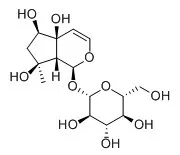| Description: |
Harpagide has neuroprotective effect, it can obviously protect acute cerebral ischemia in mice,its therapeutical effects are approached to protecting the activity of brain mitochondria and decreasing protein expression level of caspase-3; harpagide also has a potential for prevention of bone loss in ovariectomized (OVX) mice by regulating the stimulation of osteoblast differentiation and the suppression of osteoclast formation. Harpagide may have anti-inflammatory efficacy. |
| Targets: |
TNF-α | NO | COX | Caspase | Calcium Channel | ATPase |
| In vitro: |
| Bioorg Med Chem. 2011 Aug 15;19(16):4882-6. | | Effects of β-glucosidase hydrolyzed products of harpagide and harpagoside on cyclooxygenase-2 (COX-2) in vitro.[Pubmed: 21775152 ] | Harpagide (1) and harpagoside (2) are two iridoid glycosides existing in many medicinal plants. Although they are believed to be the main bioactive compounds related to the anti-inflammatory efficacy of these plants, the mechanisms of their anti-inflammatory activities remain unclear.
METHODS AND RESULTS:
The results of our present study showed that 1 and 2 had no effects on inhibitions of cyclooxygenase (COX)-1/2 enzyme activity, tumor necrosis factor-α (TNF-α) release, and nitric oxide (NO) production in vitro. However, the hydrolyzed products of 1 and 2 with β-glucosidase treatment showed a significant inhibitory effect on COX-2 activity at 2.5-100 μM in a concentration-dependent manner. Our further study revealed that the hydrolyzed 2 product was structurally the same as the hydrolyzed 1 product (H-Harpagide (3)). The structure of 3 was 2-(formylmethyl)-2,3,5-trihydroxy-5-methylcyclopentane carbaldehyde, with a backbone similar to prostaglandins and COX-2 inhibitors such as celecoxib. All of them have a pentatomic ring with two adjacent side chains.
CONCLUSIONS:
The result of molecular modeling and docking study showed that 3 could bind to the COX-2 active domain well through hydrophobic and hydrogen-bonding interactions, whereas 1 and 2 could not, implying that the hydrolysis of the glycosidic bond of 1 and 2 is a pre-requisite step for their COX-2 inhibitory activity. |
|
| In vivo: |
| Journal of Chinese Pharmaceutical Sciences, 2015, 50(12):1026-31. | | Neuro-protective effect of harpagide on acute cerebral ischemic injury in mice and its mechanism involving mitochondria.[Reference: WebLink] | To observe the neuro-protective effects of Harpagide on acute cerebral ischemic injury in mice and its mechanism involving mitochondria.
METHODS AND RESULTS:
Acute cerebral ischemia were achieved by operation of MCAO in the left brain, random allocation was taken to divide ICR mice into sham group, model group, nimodipine group and Harpagide (5,10,15 mg·kg-1) groups. Mice were intraperitoneal injected Harpagide immediately after surgeiy. Nerve function score, content of brain water, brain index and the common changes of brain pathological structure in HE staining were measured: Ability of mitochondria Ca2+-Mg2+-AT-Pase and protein expression level of caspase-3 in the MCAO mice' brains was determined: Ultrastructure change of mitochondria under the TEM was observed. Compared with model group, the Harpagide groups could decreased the nerve function score, the content of brain water, brain index and the volume of ischemia in mice with different degrees in MCAO mice (P<0.05, P<0.01). 10 mg·kg-1 of Harpagide could increased the activity of Ca2+-Mg2+-ATPase obviously (P<0.01): And significantly decreased the protein expression level of caspase-3 (P<0.01): Harpagide groups could protect the pathogeny structure and the ultrastructure of mitochondria with different degrees in MCAO mice, decrease edema of mitochondria obviously.
CONCLUSIONS:
Harpagide could obviously protect acute cerebral ischemia in mice, its therapeutical effects are approached to protecting the activity of brain mitochondria and decreasing protein expression level of caspase-3.
|
|






 Cell. 2018 Jan 11;172(1-2):249-261.e12. doi: 10.1016/j.cell.2017.12.019.IF=36.216(2019)
Cell. 2018 Jan 11;172(1-2):249-261.e12. doi: 10.1016/j.cell.2017.12.019.IF=36.216(2019) Cell Metab. 2020 Mar 3;31(3):534-548.e5. doi: 10.1016/j.cmet.2020.01.002.IF=22.415(2019)
Cell Metab. 2020 Mar 3;31(3):534-548.e5. doi: 10.1016/j.cmet.2020.01.002.IF=22.415(2019) Mol Cell. 2017 Nov 16;68(4):673-685.e6. doi: 10.1016/j.molcel.2017.10.022.IF=14.548(2019)
Mol Cell. 2017 Nov 16;68(4):673-685.e6. doi: 10.1016/j.molcel.2017.10.022.IF=14.548(2019)